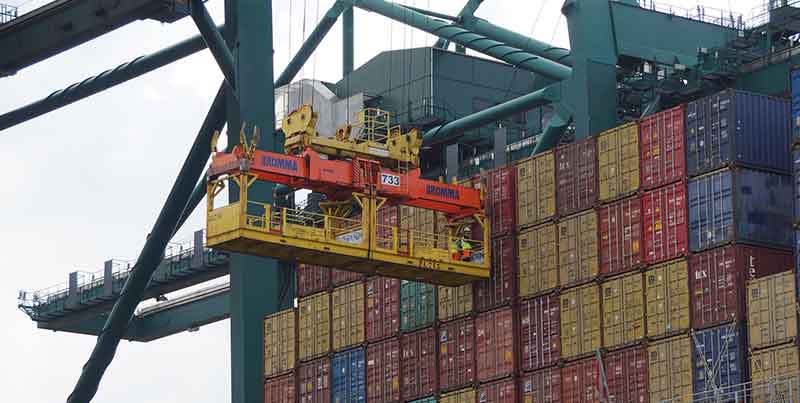Sea freight containers come in standard sizes, primarily the 20-foot, 40-foot, and 40-foot High Cube. Gaining insights into these shipping container sizes can ensure you make well-informed decisions.
Therefore, today’s guide will delve into the detailed dimensions of 20ft, 40ft, and 40ft HC containers, their respective types, weights, and capacities.
20ft shipping container size and capacities
1. 20 general-purpose container
It is the most commonly used type for transporting dry goods, including machinery, textiles, electronics, and other non-perishable items.
Below are the standard dimensions for a 20-foot GP shipping container for your reference:
Exterior dimensions:
Length: 20 feet (6.06m)
Width: 8 feet (2.44m)
Height: 8 feet 6 inches (2.59m)
Internal dimensions:
Length: 19 feet 4 inches (5.60m)
Width: 7 feet 9 inches (2.35m)
Height: 7 feet 10 inches (2.39m)
Tare weight:
Approximately 4,850 pounds (2,200kg)
Maximum payload 20 ft container:
Roughly between 48,000 to 52,000 lbs ( 21,770 to 24,000kg )
Cubic capacity:
Around 1,172 cubic feet (33CBM)
You should know that the tare weight is the container’s weight exclusive of any cargo or contents.
The payload denotes the weight of the cargo or contents the container can accommodate.
The cubic capacity refers to the total volume of 20ft container available space inside the container.
Based on the specifications, a 20ft dry container allows for carrying cargo weighing up to 24,000kg with a maximum volume of 33CBM.
2. 20ft open-top container
These containers have no roof, which allows for easy loading and unloading of cargo from the top using cranes or other equipment. A removable tarpaulin or soft top covers the opening, offering protection from weather conditions.
External dimensions:
Length: 20 feet (6.06m)
Width: 8 feet (2.44m)
Height: 8.6 feet (2.59m)
Internal dimensions:
Length: 19.4 feet (5.89m)
Width: 7.7 feet (2.34m)
Height: Variable, but typically around 7.7 feet (2.34m)
Tare weight:
Roughly 4,900 lbs (2,250kg)
Maximum payload:
About 62,300 lbs (28,230kg)
Cubic capacity:
Approximately 1,155 cubic feet/(32.7CBM
3. 20ft flat rack container
It is a shipping container designed without side walls and roof and has a removable or fixed-end wall. This design allows for easy loading and unloading of oversized cargo that cannot fit into standard containers due to their size or shape.
External dimensions:
Length: 20 feet (6.06m)
Width: 8 feet (2.44m)
Height: 7.9 feet (2.4m)
Internal dimensions:
Length: 18.6 feet (5.69m)
Width: 7.7 feet (2.34 m)
Height: Approximately 7.7 feet (2.34m)
Tare weight:
About 5,070lbs (2,300kg)
Maximum payload:
Around 67,200 lbs (30,480kg)
Cubic capacity:
1,154 cubic feet(32.7CBM)
4. 20ft reefer containers
It is used for transporting perishable goods requiring temperature-controlled environments, such as fruits, vegetables, meat, pharmaceuticals, and more.
External dimensions:
Length: 20 feet (6.06m)
Width: 8 feet (2.44m)
Height: 8.6 feet (2.59m)
Internal dimensions:
Length: 17.4 feet (5.28m)
Width: 7.7 feet (2.29m)
Height: 7.5 feet (2.26m)
Tare weight:
6,790 lbs (3,080kg)
Maximum payload:
Roughly 62,350 lbs (28,280kg)
Cubic capacity:
1,000 cubic feet (28.3CBM)

40ft shipping container size and capacities
The 40-foot container is also available in specialized variants such as reefers, open-tops, and more. Continue reading to discover the dimensions of 40ft containers.
1. 40 general-purpose container
External dimensions:
Length: 40 feet (12.19m)
Width: 8 feet (2.44m)
Height: 8 feet 6 inches (2.59m)
Interior dimensions:
Length: 39 feet 5.5 inches (12.03m)
Width: 7 feet 8 inches (2.35m)
Height: 7 feet 9.5 inches (2.38m)
Tare weight:
Approximately 8,200 lbs (3,720 kg)
Maximum payload of 40ft container:
58,920 lbs (26,760 kg)
Cubic capacity:
2,389 cubic feet(67.7CBM)
2. 40ft open-top container
External dimensions:
Length: 40 feet (12.19m)
Width: 8 feet (2.44m)
Height: 8 feet 6 inches (2.59m)
Interior dimensions:
Length: 39 feet 5.5 inches (12.03m)
Width: 7 feet 8 inches (2.34m)
Height: 7 feet 8 inches (2.34m)
Tare weight:
Approximately 8,400 lbs (3,810 kg)
Maximum payload:
About 58,800 lbs (26,670 kg)
Cubic capacity:
2,360 cubic feet (66.7CBM)
3. 40ft flat rack container
External dimensions:
Length: 40 feet (12.19m)
Width: 8 feet (2.44m)
Height: 7 feet (2.14m)
Interior dimensions:
Length: 39 feet (11.89 m)
Width: 7.7 feet (2.34 m)
Height: 7 feet (2.14m)
Tare weight:
11,025 lbs (5,000 kg)
Maximum payload:
Roughly 88,200 lbs (40,000 kg)
Cubic capacity:
Around 2,195.7 cubic feet (62.2 CBM)
4. 40ft reefer container
External dimensions:
Length: 40 feet (12.19 m)
Width: 8 feet (2.44 m)
Height: 8.6 feet (2.59 m)
Interior dimensions:
Length: 37.7 feet (11.49 m)
Width: 7.7 feet (2.33 m)
Height: 7.6 feet (2.29 m)
Tare weight:
9,744 lbs (4,420 kg)
Maximum payload:
65,212 lbs (29,580 kg)
Cubic capacity:
Approximately 2,388 cubic feet (67.6 CBM)
40HC shipping container size and capacities
High cube container sizes boast an additional foot (12 inches or 30cm) in height than standard dry containers. Below are the detailed specifications for a 40ft high cube container:
External dimensions:
Length: 40 feet (12.19 m)
Width: 8 feet (2.44 m)
Height: 9 feet 6 inches (2.90 m)
Internal dimensions:
Length: 39 feet 5 inches (12.03m)
Width: 7 feet 8 inches (2.35m)
Height: 8 feet 10 inches (2.70m)
Tare weight:
8,598 lbs (2,900 kg)
Maximum payload:
65,212 lbs (29,580 kg)
Cubic capacity:
2,694 cubic feet (76.2CBM)
What is a high cube container used for?
Generally, the primary purpose of a HC container is to accommodate larger or taller cargo, providing increased volume capacity. Items such as industrial equipment, oversized crates, or certain types of furniture can benefit from this container type.
To provide a more intuitive understanding of how much cargo a 40HC container can fit, here are some examples:
If you use European pallet size (48 in x 30 in/1.2 m x 0.8 m), you can store approximately 23-25 pallets in a 40ft high cube container.
While with American pallets (48 in x 40 in/1.2 m x 1 m), you can fit around 20-21 stacks, provided they don’t extend beyond the container’s sides.
How many pallets can fit into a container?
As mentioned above, a standard European pallet typically measures 1200 mm x 800 mm, whereas an American one is 1200 mm x 1000 mm.
When arranging European pallets in a single layer without any wasted space between pallets or at the container walls, a 20-foot container can carry around 11 Euro pallets. In contrast, a 40-foot shipping container can carry between 23 to 24 pallets.
Regarding American standard pallets, a 20-foot shipping container can hold 10 to 11 pallets in one tier. And a 40-foot container can fit between 20 to 21 pallets on the base.
It’s important to note that practical shipping scenarios may vary due to stacking efficiency, cargo shape, and loading equipment. You can send your cargo details to our expert, who can offer you the most suitable customized solutions. And maximize the container volume utilization tailored to your requirements.
Best practices for optimizing container utilization
Cargo planning and preparation
- Evaluate and categorize cargo based on size, weight, and fragility.
- Pack smaller items into larger containers to reduce unused space.
Optimize space with stacking and racking systems
- Stack cargo efficiently while considering weight distribution and stability to prevent shifting during transportation.
- Utilize pallets, racks, or shelving systems designed for efficient container loading.
- Use stacking techniques to utilize vertical space without compromising cargo integrity.
Implement consolidation and deconsolidation strategies
- Enhance the use of your containers by grouping and splitting your cargo based on destination, demand, and accessibility.
- Consolidation involves combining multiple shipments from different sources into one container. It can minimize the number of containers needed and improve the load capacity.
- Deconsolidation entails dividing a single container into multiple shipments for specific destinations. It aims to reduce the transit time and cost of delivery.
Conclusion
Now that you are familiar with the standard shipping container sizes of 20ft, 40ft, and 40ft HC. So you can select the most suitable one for your international shipping needs.
At Airsupply, we offer a range of container types and sizes, providing both LCL and FCL shipping options. Moreover, by booking directly with the ship owner, you gain access to the most competitive prices available in the market through us!




